THE INTERNATIONAL MANAGEMENT
VerifiedAdded on 2022/09/08
|10
|2668
|26
AI Summary
Contribute Materials
Your contribution can guide someone’s learning journey. Share your
documents today.
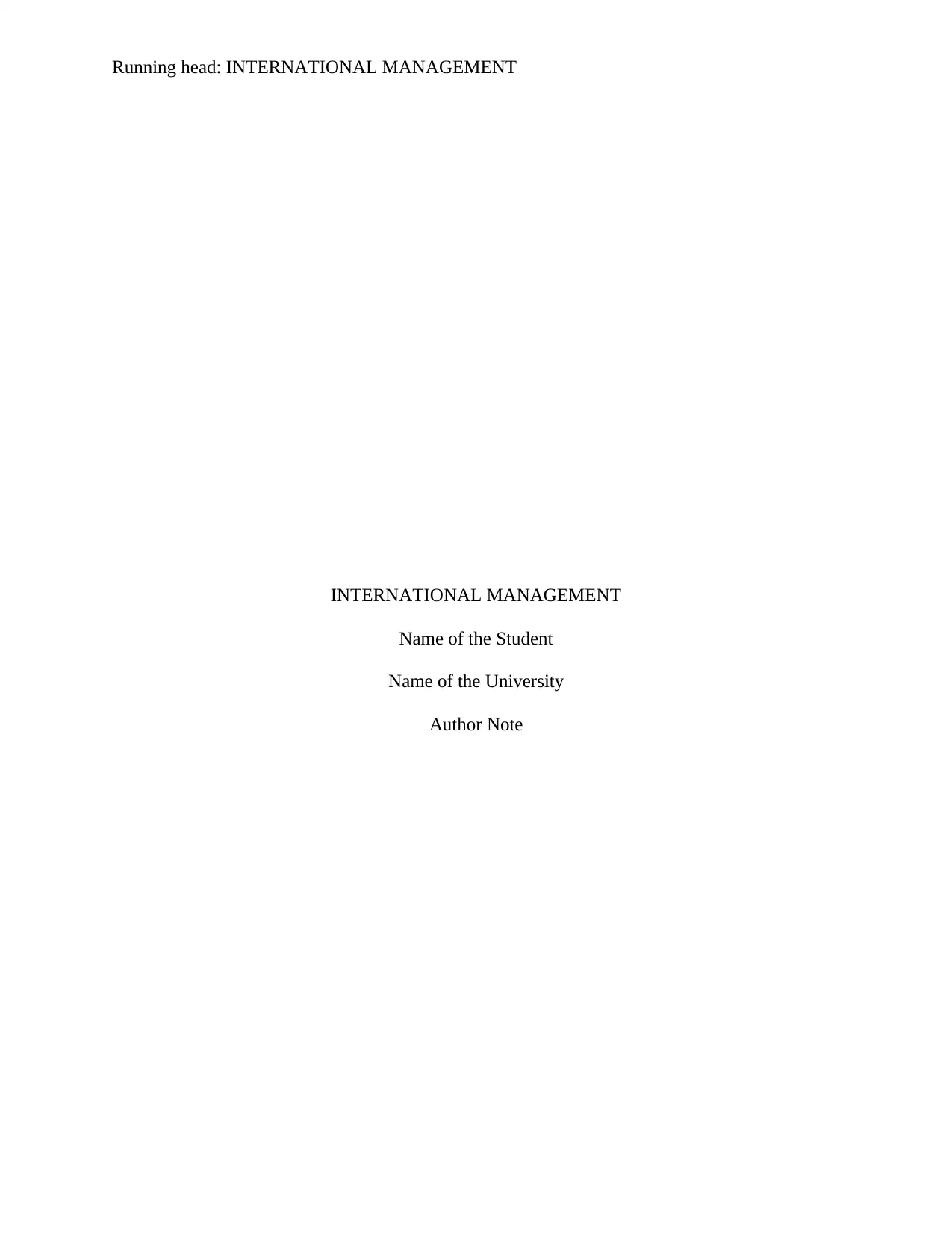
Running head: INTERNATIONAL MANAGEMENT
INTERNATIONAL MANAGEMENT
Name of the Student
Name of the University
Author Note
INTERNATIONAL MANAGEMENT
Name of the Student
Name of the University
Author Note
Secure Best Marks with AI Grader
Need help grading? Try our AI Grader for instant feedback on your assignments.
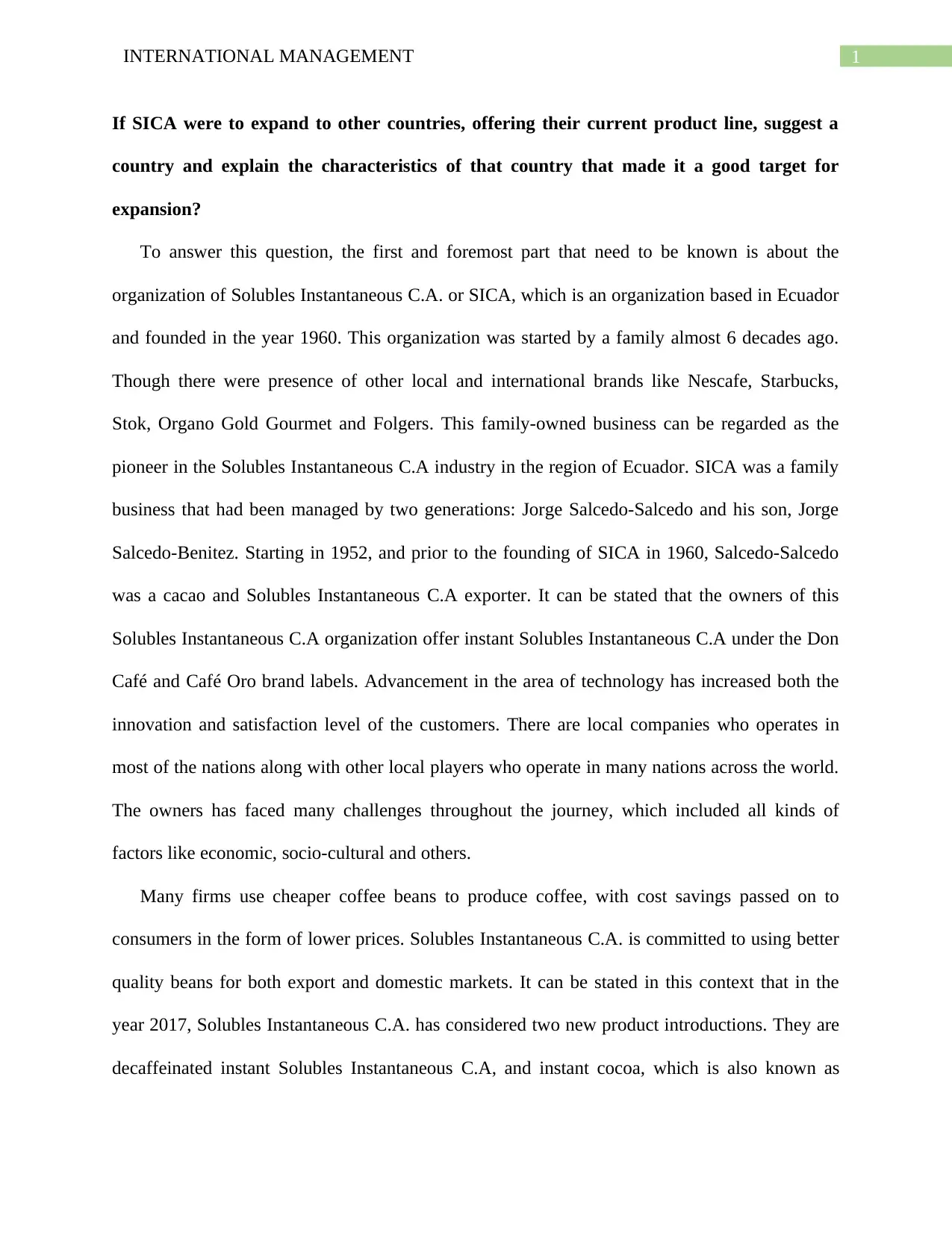
1INTERNATIONAL MANAGEMENT
If SICA were to expand to other countries, offering their current product line, suggest a
country and explain the characteristics of that country that made it a good target for
expansion?
To answer this question, the first and foremost part that need to be known is about the
organization of Solubles Instantaneous C.A. or SICA, which is an organization based in Ecuador
and founded in the year 1960. This organization was started by a family almost 6 decades ago.
Though there were presence of other local and international brands like Nescafe, Starbucks,
Stok, Organo Gold Gourmet and Folgers. This family-owned business can be regarded as the
pioneer in the Solubles Instantaneous C.A industry in the region of Ecuador. SICA was a family
business that had been managed by two generations: Jorge Salcedo-Salcedo and his son, Jorge
Salcedo-Benitez. Starting in 1952, and prior to the founding of SICA in 1960, Salcedo-Salcedo
was a cacao and Solubles Instantaneous C.A exporter. It can be stated that the owners of this
Solubles Instantaneous C.A organization offer instant Solubles Instantaneous C.A under the Don
Café and Café Oro brand labels. Advancement in the area of technology has increased both the
innovation and satisfaction level of the customers. There are local companies who operates in
most of the nations along with other local players who operate in many nations across the world.
The owners has faced many challenges throughout the journey, which included all kinds of
factors like economic, socio-cultural and others.
Many firms use cheaper coffee beans to produce coffee, with cost savings passed on to
consumers in the form of lower prices. Solubles Instantaneous C.A. is committed to using better
quality beans for both export and domestic markets. It can be stated in this context that in the
year 2017, Solubles Instantaneous C.A. has considered two new product introductions. They are
decaffeinated instant Solubles Instantaneous C.A, and instant cocoa, which is also known as
If SICA were to expand to other countries, offering their current product line, suggest a
country and explain the characteristics of that country that made it a good target for
expansion?
To answer this question, the first and foremost part that need to be known is about the
organization of Solubles Instantaneous C.A. or SICA, which is an organization based in Ecuador
and founded in the year 1960. This organization was started by a family almost 6 decades ago.
Though there were presence of other local and international brands like Nescafe, Starbucks,
Stok, Organo Gold Gourmet and Folgers. This family-owned business can be regarded as the
pioneer in the Solubles Instantaneous C.A industry in the region of Ecuador. SICA was a family
business that had been managed by two generations: Jorge Salcedo-Salcedo and his son, Jorge
Salcedo-Benitez. Starting in 1952, and prior to the founding of SICA in 1960, Salcedo-Salcedo
was a cacao and Solubles Instantaneous C.A exporter. It can be stated that the owners of this
Solubles Instantaneous C.A organization offer instant Solubles Instantaneous C.A under the Don
Café and Café Oro brand labels. Advancement in the area of technology has increased both the
innovation and satisfaction level of the customers. There are local companies who operates in
most of the nations along with other local players who operate in many nations across the world.
The owners has faced many challenges throughout the journey, which included all kinds of
factors like economic, socio-cultural and others.
Many firms use cheaper coffee beans to produce coffee, with cost savings passed on to
consumers in the form of lower prices. Solubles Instantaneous C.A. is committed to using better
quality beans for both export and domestic markets. It can be stated in this context that in the
year 2017, Solubles Instantaneous C.A. has considered two new product introductions. They are
decaffeinated instant Solubles Instantaneous C.A, and instant cocoa, which is also known as
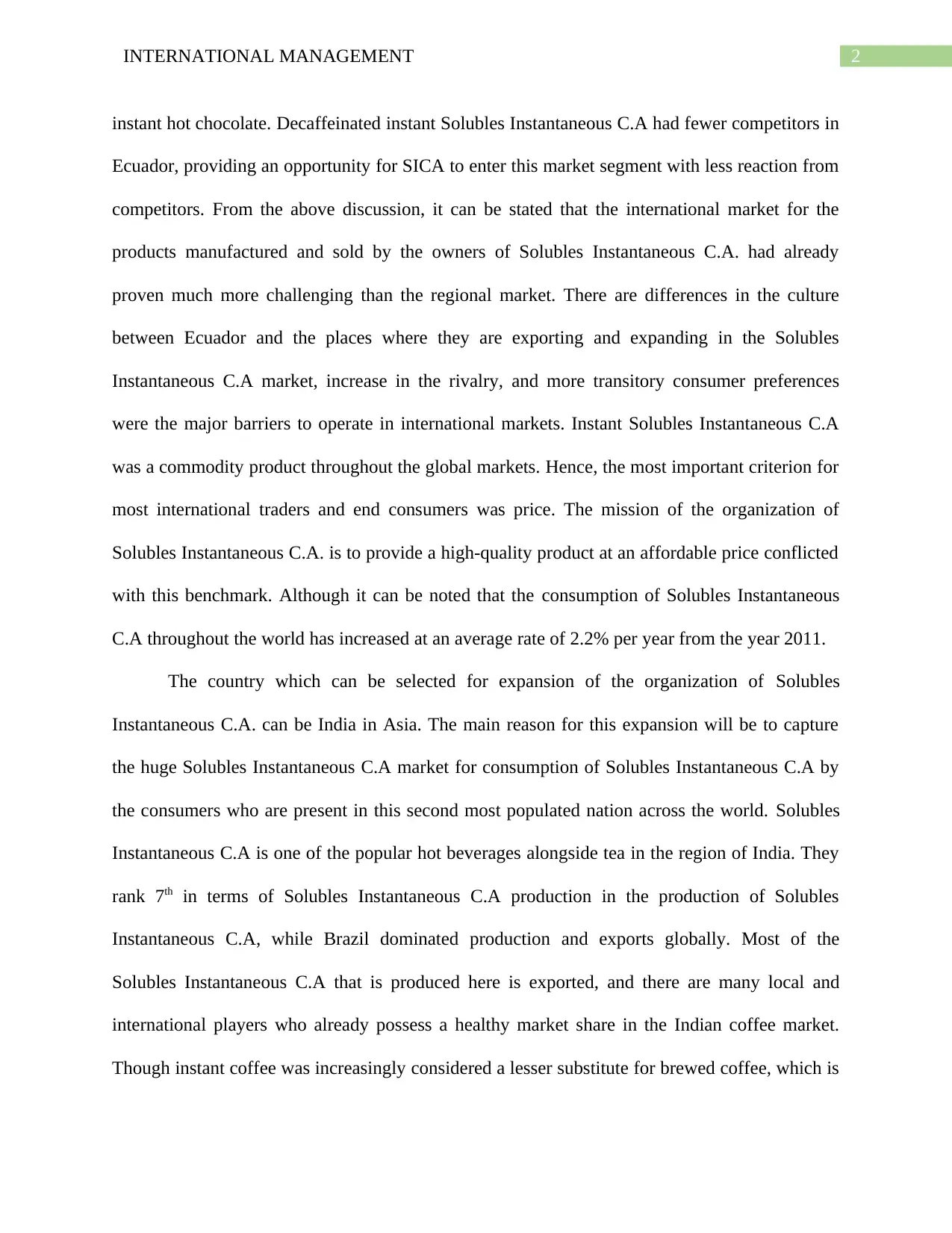
2INTERNATIONAL MANAGEMENT
instant hot chocolate. Decaffeinated instant Solubles Instantaneous C.A had fewer competitors in
Ecuador, providing an opportunity for SICA to enter this market segment with less reaction from
competitors. From the above discussion, it can be stated that the international market for the
products manufactured and sold by the owners of Solubles Instantaneous C.A. had already
proven much more challenging than the regional market. There are differences in the culture
between Ecuador and the places where they are exporting and expanding in the Solubles
Instantaneous C.A market, increase in the rivalry, and more transitory consumer preferences
were the major barriers to operate in international markets. Instant Solubles Instantaneous C.A
was a commodity product throughout the global markets. Hence, the most important criterion for
most international traders and end consumers was price. The mission of the organization of
Solubles Instantaneous C.A. is to provide a high-quality product at an affordable price conflicted
with this benchmark. Although it can be noted that the consumption of Solubles Instantaneous
C.A throughout the world has increased at an average rate of 2.2% per year from the year 2011.
The country which can be selected for expansion of the organization of Solubles
Instantaneous C.A. can be India in Asia. The main reason for this expansion will be to capture
the huge Solubles Instantaneous C.A market for consumption of Solubles Instantaneous C.A by
the consumers who are present in this second most populated nation across the world. Solubles
Instantaneous C.A is one of the popular hot beverages alongside tea in the region of India. They
rank 7th in terms of Solubles Instantaneous C.A production in the production of Solubles
Instantaneous C.A, while Brazil dominated production and exports globally. Most of the
Solubles Instantaneous C.A that is produced here is exported, and there are many local and
international players who already possess a healthy market share in the Indian coffee market.
Though instant coffee was increasingly considered a lesser substitute for brewed coffee, which is
instant hot chocolate. Decaffeinated instant Solubles Instantaneous C.A had fewer competitors in
Ecuador, providing an opportunity for SICA to enter this market segment with less reaction from
competitors. From the above discussion, it can be stated that the international market for the
products manufactured and sold by the owners of Solubles Instantaneous C.A. had already
proven much more challenging than the regional market. There are differences in the culture
between Ecuador and the places where they are exporting and expanding in the Solubles
Instantaneous C.A market, increase in the rivalry, and more transitory consumer preferences
were the major barriers to operate in international markets. Instant Solubles Instantaneous C.A
was a commodity product throughout the global markets. Hence, the most important criterion for
most international traders and end consumers was price. The mission of the organization of
Solubles Instantaneous C.A. is to provide a high-quality product at an affordable price conflicted
with this benchmark. Although it can be noted that the consumption of Solubles Instantaneous
C.A throughout the world has increased at an average rate of 2.2% per year from the year 2011.
The country which can be selected for expansion of the organization of Solubles
Instantaneous C.A. can be India in Asia. The main reason for this expansion will be to capture
the huge Solubles Instantaneous C.A market for consumption of Solubles Instantaneous C.A by
the consumers who are present in this second most populated nation across the world. Solubles
Instantaneous C.A is one of the popular hot beverages alongside tea in the region of India. They
rank 7th in terms of Solubles Instantaneous C.A production in the production of Solubles
Instantaneous C.A, while Brazil dominated production and exports globally. Most of the
Solubles Instantaneous C.A that is produced here is exported, and there are many local and
international players who already possess a healthy market share in the Indian coffee market.
Though instant coffee was increasingly considered a lesser substitute for brewed coffee, which is
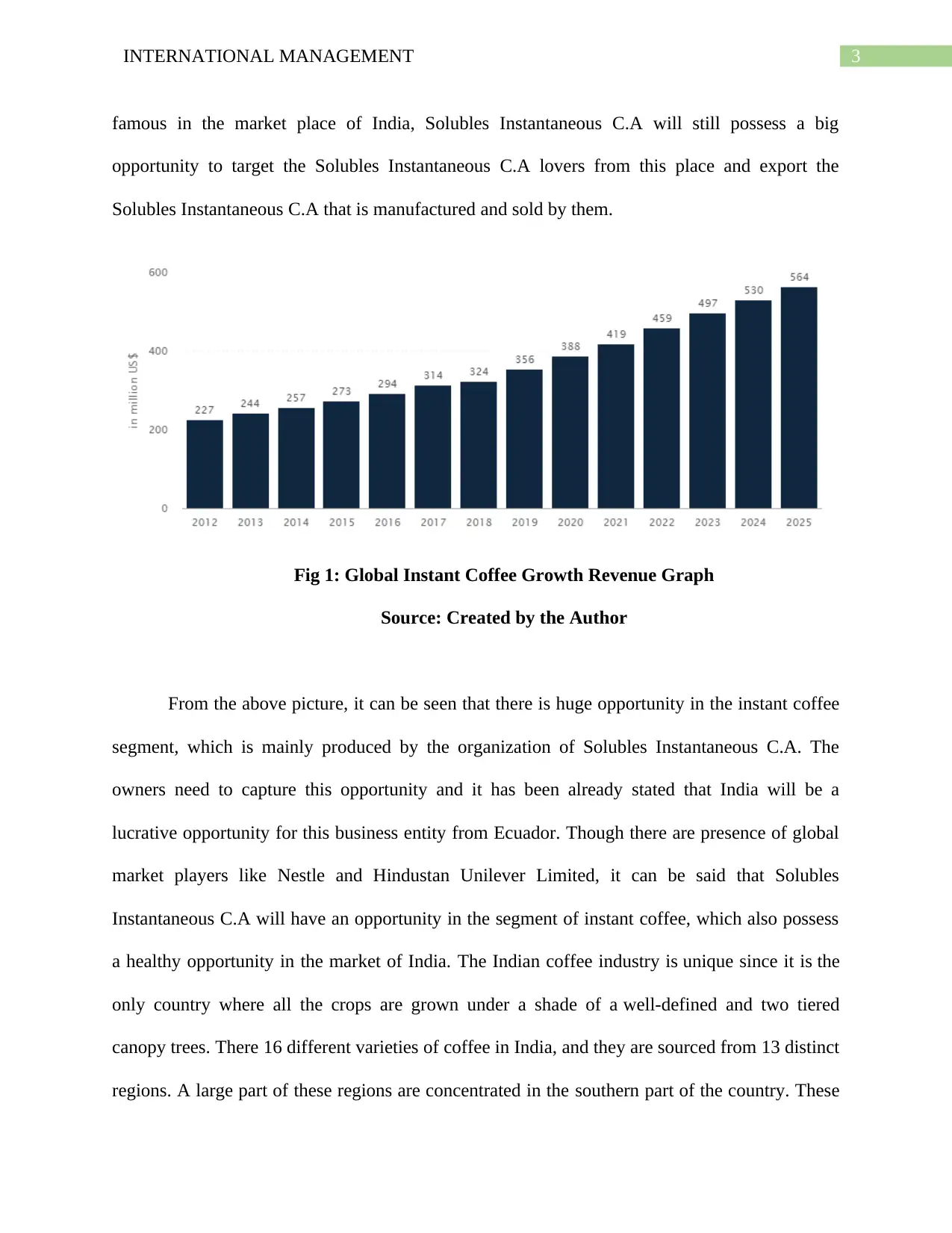
3INTERNATIONAL MANAGEMENT
famous in the market place of India, Solubles Instantaneous C.A will still possess a big
opportunity to target the Solubles Instantaneous C.A lovers from this place and export the
Solubles Instantaneous C.A that is manufactured and sold by them.
Fig 1: Global Instant Coffee Growth Revenue Graph
Source: Created by the Author
From the above picture, it can be seen that there is huge opportunity in the instant coffee
segment, which is mainly produced by the organization of Solubles Instantaneous C.A. The
owners need to capture this opportunity and it has been already stated that India will be a
lucrative opportunity for this business entity from Ecuador. Though there are presence of global
market players like Nestle and Hindustan Unilever Limited, it can be said that Solubles
Instantaneous C.A will have an opportunity in the segment of instant coffee, which also possess
a healthy opportunity in the market of India. The Indian coffee industry is unique since it is the
only country where all the crops are grown under a shade of a well-defined and two tiered
canopy trees. There 16 different varieties of coffee in India, and they are sourced from 13 distinct
regions. A large part of these regions are concentrated in the southern part of the country. These
famous in the market place of India, Solubles Instantaneous C.A will still possess a big
opportunity to target the Solubles Instantaneous C.A lovers from this place and export the
Solubles Instantaneous C.A that is manufactured and sold by them.
Fig 1: Global Instant Coffee Growth Revenue Graph
Source: Created by the Author
From the above picture, it can be seen that there is huge opportunity in the instant coffee
segment, which is mainly produced by the organization of Solubles Instantaneous C.A. The
owners need to capture this opportunity and it has been already stated that India will be a
lucrative opportunity for this business entity from Ecuador. Though there are presence of global
market players like Nestle and Hindustan Unilever Limited, it can be said that Solubles
Instantaneous C.A will have an opportunity in the segment of instant coffee, which also possess
a healthy opportunity in the market of India. The Indian coffee industry is unique since it is the
only country where all the crops are grown under a shade of a well-defined and two tiered
canopy trees. There 16 different varieties of coffee in India, and they are sourced from 13 distinct
regions. A large part of these regions are concentrated in the southern part of the country. These
Secure Best Marks with AI Grader
Need help grading? Try our AI Grader for instant feedback on your assignments.
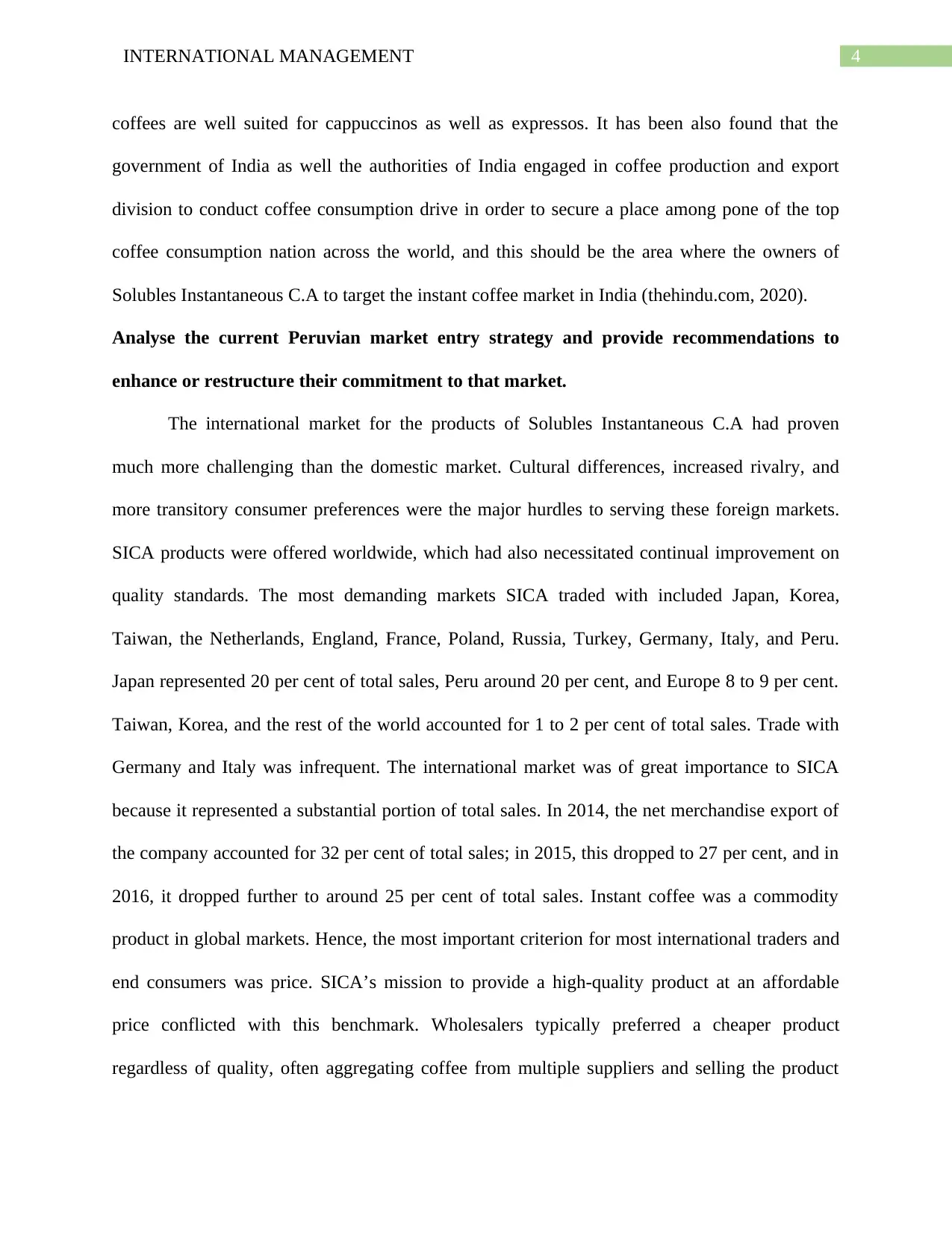
4INTERNATIONAL MANAGEMENT
coffees are well suited for cappuccinos as well as expressos. It has been also found that the
government of India as well the authorities of India engaged in coffee production and export
division to conduct coffee consumption drive in order to secure a place among pone of the top
coffee consumption nation across the world, and this should be the area where the owners of
Solubles Instantaneous C.A to target the instant coffee market in India (thehindu.com, 2020).
Analyse the current Peruvian market entry strategy and provide recommendations to
enhance or restructure their commitment to that market.
The international market for the products of Solubles Instantaneous C.A had proven
much more challenging than the domestic market. Cultural differences, increased rivalry, and
more transitory consumer preferences were the major hurdles to serving these foreign markets.
SICA products were offered worldwide, which had also necessitated continual improvement on
quality standards. The most demanding markets SICA traded with included Japan, Korea,
Taiwan, the Netherlands, England, France, Poland, Russia, Turkey, Germany, Italy, and Peru.
Japan represented 20 per cent of total sales, Peru around 20 per cent, and Europe 8 to 9 per cent.
Taiwan, Korea, and the rest of the world accounted for 1 to 2 per cent of total sales. Trade with
Germany and Italy was infrequent. The international market was of great importance to SICA
because it represented a substantial portion of total sales. In 2014, the net merchandise export of
the company accounted for 32 per cent of total sales; in 2015, this dropped to 27 per cent, and in
2016, it dropped further to around 25 per cent of total sales. Instant coffee was a commodity
product in global markets. Hence, the most important criterion for most international traders and
end consumers was price. SICA’s mission to provide a high-quality product at an affordable
price conflicted with this benchmark. Wholesalers typically preferred a cheaper product
regardless of quality, often aggregating coffee from multiple suppliers and selling the product
coffees are well suited for cappuccinos as well as expressos. It has been also found that the
government of India as well the authorities of India engaged in coffee production and export
division to conduct coffee consumption drive in order to secure a place among pone of the top
coffee consumption nation across the world, and this should be the area where the owners of
Solubles Instantaneous C.A to target the instant coffee market in India (thehindu.com, 2020).
Analyse the current Peruvian market entry strategy and provide recommendations to
enhance or restructure their commitment to that market.
The international market for the products of Solubles Instantaneous C.A had proven
much more challenging than the domestic market. Cultural differences, increased rivalry, and
more transitory consumer preferences were the major hurdles to serving these foreign markets.
SICA products were offered worldwide, which had also necessitated continual improvement on
quality standards. The most demanding markets SICA traded with included Japan, Korea,
Taiwan, the Netherlands, England, France, Poland, Russia, Turkey, Germany, Italy, and Peru.
Japan represented 20 per cent of total sales, Peru around 20 per cent, and Europe 8 to 9 per cent.
Taiwan, Korea, and the rest of the world accounted for 1 to 2 per cent of total sales. Trade with
Germany and Italy was infrequent. The international market was of great importance to SICA
because it represented a substantial portion of total sales. In 2014, the net merchandise export of
the company accounted for 32 per cent of total sales; in 2015, this dropped to 27 per cent, and in
2016, it dropped further to around 25 per cent of total sales. Instant coffee was a commodity
product in global markets. Hence, the most important criterion for most international traders and
end consumers was price. SICA’s mission to provide a high-quality product at an affordable
price conflicted with this benchmark. Wholesalers typically preferred a cheaper product
regardless of quality, often aggregating coffee from multiple suppliers and selling the product
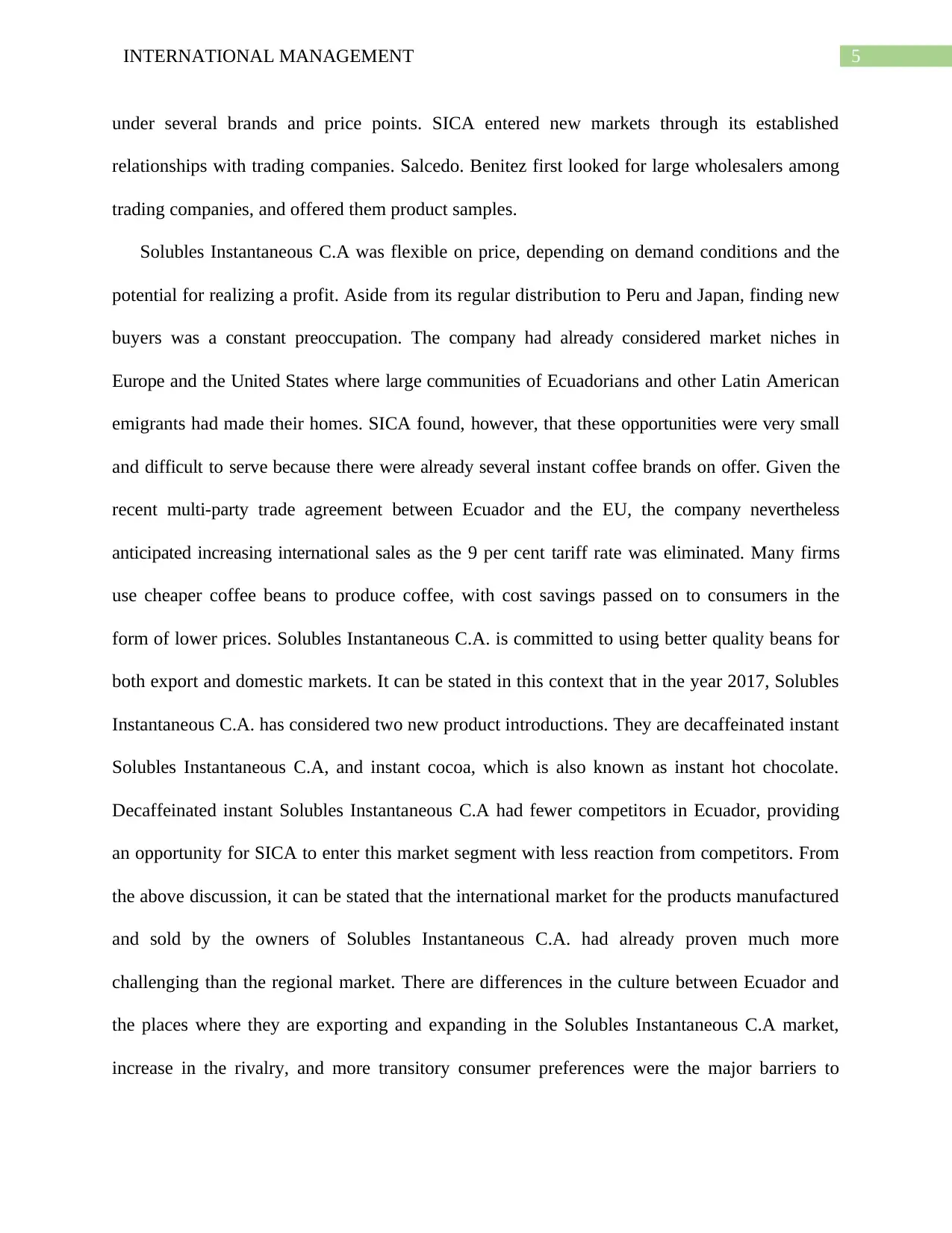
5INTERNATIONAL MANAGEMENT
under several brands and price points. SICA entered new markets through its established
relationships with trading companies. Salcedo. Benitez first looked for large wholesalers among
trading companies, and offered them product samples.
Solubles Instantaneous C.A was flexible on price, depending on demand conditions and the
potential for realizing a profit. Aside from its regular distribution to Peru and Japan, finding new
buyers was a constant preoccupation. The company had already considered market niches in
Europe and the United States where large communities of Ecuadorians and other Latin American
emigrants had made their homes. SICA found, however, that these opportunities were very small
and difficult to serve because there were already several instant coffee brands on offer. Given the
recent multi-party trade agreement between Ecuador and the EU, the company nevertheless
anticipated increasing international sales as the 9 per cent tariff rate was eliminated. Many firms
use cheaper coffee beans to produce coffee, with cost savings passed on to consumers in the
form of lower prices. Solubles Instantaneous C.A. is committed to using better quality beans for
both export and domestic markets. It can be stated in this context that in the year 2017, Solubles
Instantaneous C.A. has considered two new product introductions. They are decaffeinated instant
Solubles Instantaneous C.A, and instant cocoa, which is also known as instant hot chocolate.
Decaffeinated instant Solubles Instantaneous C.A had fewer competitors in Ecuador, providing
an opportunity for SICA to enter this market segment with less reaction from competitors. From
the above discussion, it can be stated that the international market for the products manufactured
and sold by the owners of Solubles Instantaneous C.A. had already proven much more
challenging than the regional market. There are differences in the culture between Ecuador and
the places where they are exporting and expanding in the Solubles Instantaneous C.A market,
increase in the rivalry, and more transitory consumer preferences were the major barriers to
under several brands and price points. SICA entered new markets through its established
relationships with trading companies. Salcedo. Benitez first looked for large wholesalers among
trading companies, and offered them product samples.
Solubles Instantaneous C.A was flexible on price, depending on demand conditions and the
potential for realizing a profit. Aside from its regular distribution to Peru and Japan, finding new
buyers was a constant preoccupation. The company had already considered market niches in
Europe and the United States where large communities of Ecuadorians and other Latin American
emigrants had made their homes. SICA found, however, that these opportunities were very small
and difficult to serve because there were already several instant coffee brands on offer. Given the
recent multi-party trade agreement between Ecuador and the EU, the company nevertheless
anticipated increasing international sales as the 9 per cent tariff rate was eliminated. Many firms
use cheaper coffee beans to produce coffee, with cost savings passed on to consumers in the
form of lower prices. Solubles Instantaneous C.A. is committed to using better quality beans for
both export and domestic markets. It can be stated in this context that in the year 2017, Solubles
Instantaneous C.A. has considered two new product introductions. They are decaffeinated instant
Solubles Instantaneous C.A, and instant cocoa, which is also known as instant hot chocolate.
Decaffeinated instant Solubles Instantaneous C.A had fewer competitors in Ecuador, providing
an opportunity for SICA to enter this market segment with less reaction from competitors. From
the above discussion, it can be stated that the international market for the products manufactured
and sold by the owners of Solubles Instantaneous C.A. had already proven much more
challenging than the regional market. There are differences in the culture between Ecuador and
the places where they are exporting and expanding in the Solubles Instantaneous C.A market,
increase in the rivalry, and more transitory consumer preferences were the major barriers to
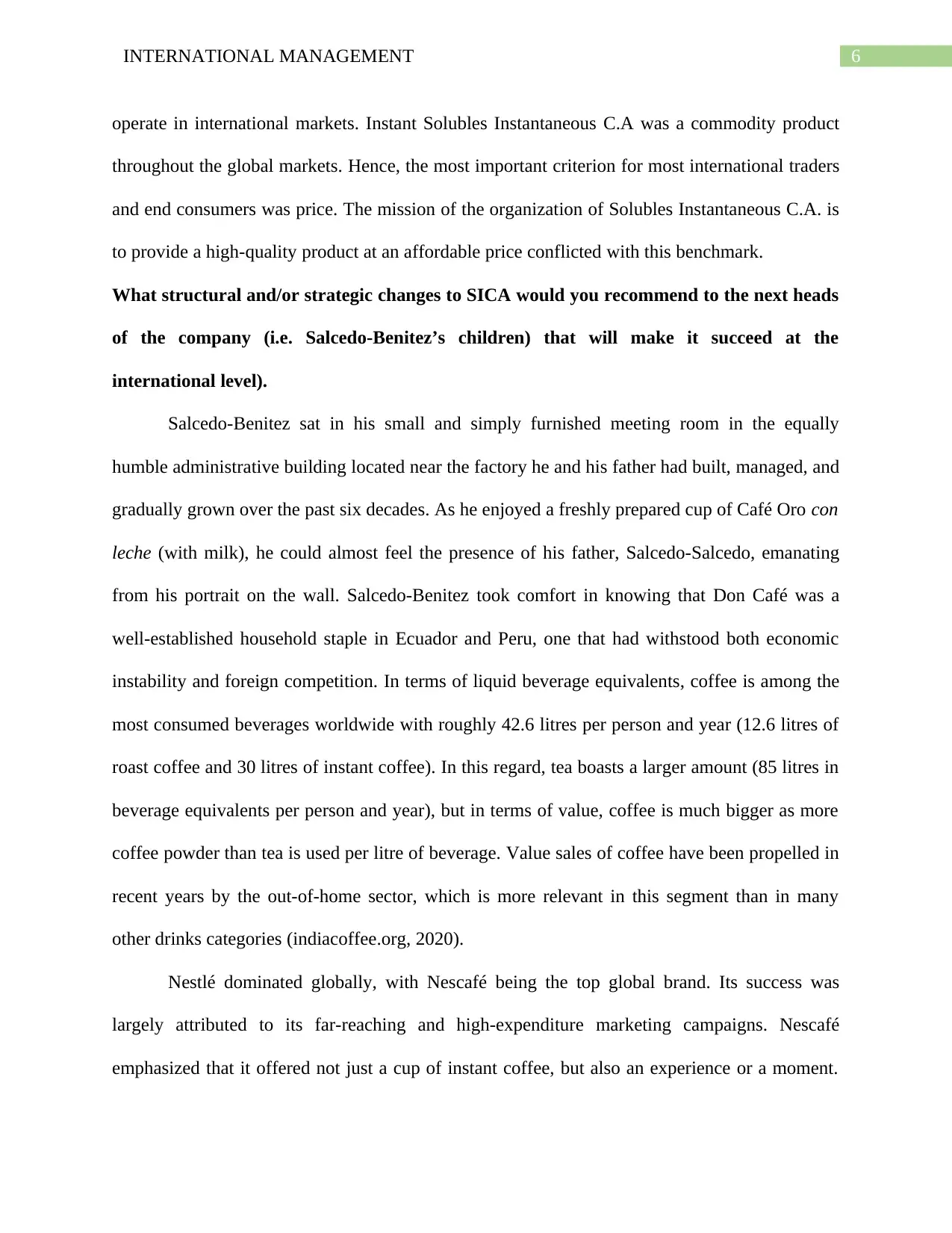
6INTERNATIONAL MANAGEMENT
operate in international markets. Instant Solubles Instantaneous C.A was a commodity product
throughout the global markets. Hence, the most important criterion for most international traders
and end consumers was price. The mission of the organization of Solubles Instantaneous C.A. is
to provide a high-quality product at an affordable price conflicted with this benchmark.
What structural and/or strategic changes to SICA would you recommend to the next heads
of the company (i.e. Salcedo-Benitez’s children) that will make it succeed at the
international level).
Salcedo-Benitez sat in his small and simply furnished meeting room in the equally
humble administrative building located near the factory he and his father had built, managed, and
gradually grown over the past six decades. As he enjoyed a freshly prepared cup of Café Oro con
leche (with milk), he could almost feel the presence of his father, Salcedo-Salcedo, emanating
from his portrait on the wall. Salcedo-Benitez took comfort in knowing that Don Café was a
well-established household staple in Ecuador and Peru, one that had withstood both economic
instability and foreign competition. In terms of liquid beverage equivalents, coffee is among the
most consumed beverages worldwide with roughly 42.6 litres per person and year (12.6 litres of
roast coffee and 30 litres of instant coffee). In this regard, tea boasts a larger amount (85 litres in
beverage equivalents per person and year), but in terms of value, coffee is much bigger as more
coffee powder than tea is used per litre of beverage. Value sales of coffee have been propelled in
recent years by the out-of-home sector, which is more relevant in this segment than in many
other drinks categories (indiacoffee.org, 2020).
Nestlé dominated globally, with Nescafé being the top global brand. Its success was
largely attributed to its far-reaching and high-expenditure marketing campaigns. Nescafé
emphasized that it offered not just a cup of instant coffee, but also an experience or a moment.
operate in international markets. Instant Solubles Instantaneous C.A was a commodity product
throughout the global markets. Hence, the most important criterion for most international traders
and end consumers was price. The mission of the organization of Solubles Instantaneous C.A. is
to provide a high-quality product at an affordable price conflicted with this benchmark.
What structural and/or strategic changes to SICA would you recommend to the next heads
of the company (i.e. Salcedo-Benitez’s children) that will make it succeed at the
international level).
Salcedo-Benitez sat in his small and simply furnished meeting room in the equally
humble administrative building located near the factory he and his father had built, managed, and
gradually grown over the past six decades. As he enjoyed a freshly prepared cup of Café Oro con
leche (with milk), he could almost feel the presence of his father, Salcedo-Salcedo, emanating
from his portrait on the wall. Salcedo-Benitez took comfort in knowing that Don Café was a
well-established household staple in Ecuador and Peru, one that had withstood both economic
instability and foreign competition. In terms of liquid beverage equivalents, coffee is among the
most consumed beverages worldwide with roughly 42.6 litres per person and year (12.6 litres of
roast coffee and 30 litres of instant coffee). In this regard, tea boasts a larger amount (85 litres in
beverage equivalents per person and year), but in terms of value, coffee is much bigger as more
coffee powder than tea is used per litre of beverage. Value sales of coffee have been propelled in
recent years by the out-of-home sector, which is more relevant in this segment than in many
other drinks categories (indiacoffee.org, 2020).
Nestlé dominated globally, with Nescafé being the top global brand. Its success was
largely attributed to its far-reaching and high-expenditure marketing campaigns. Nescafé
emphasized that it offered not just a cup of instant coffee, but also an experience or a moment.
Paraphrase This Document
Need a fresh take? Get an instant paraphrase of this document with our AI Paraphraser
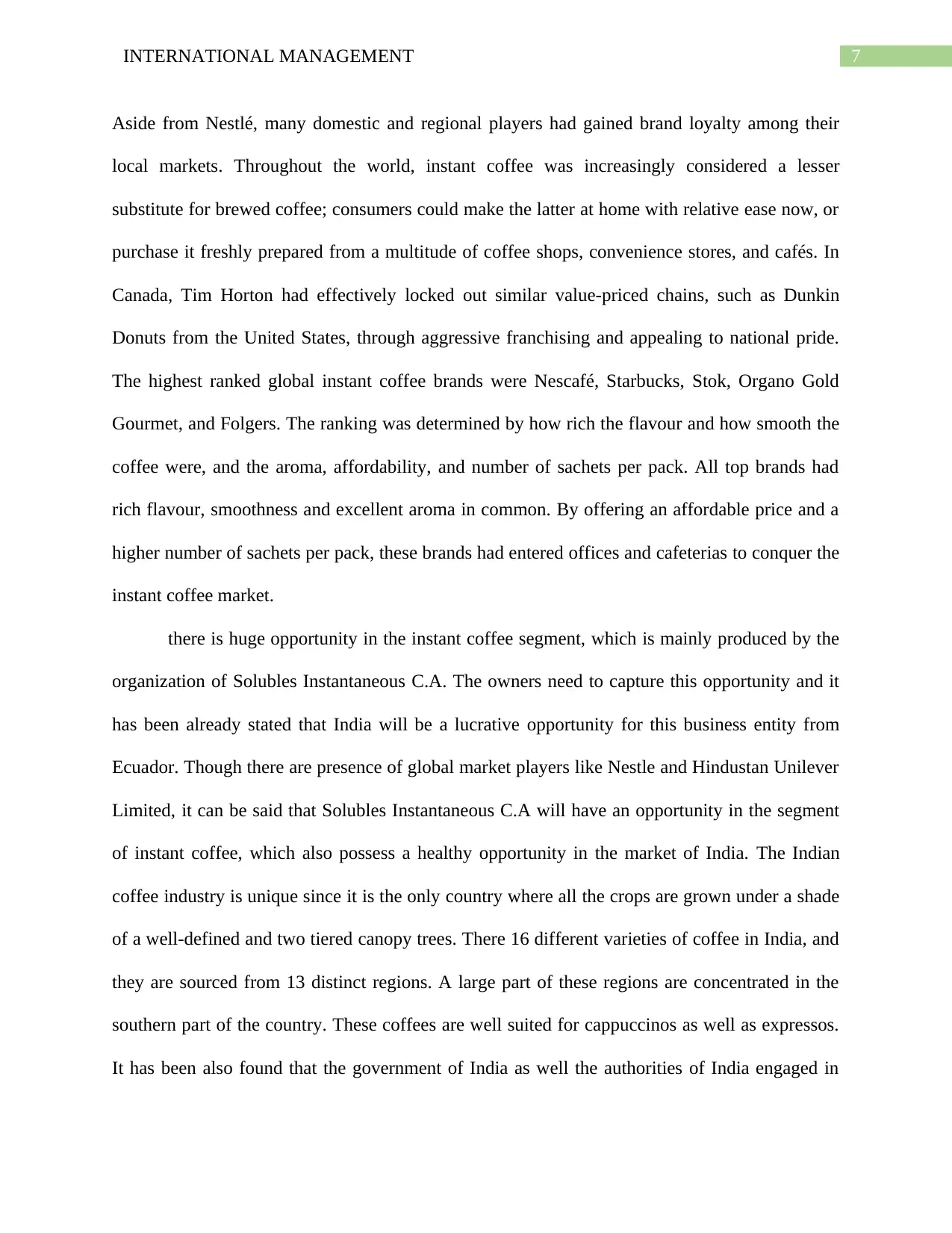
7INTERNATIONAL MANAGEMENT
Aside from Nestlé, many domestic and regional players had gained brand loyalty among their
local markets. Throughout the world, instant coffee was increasingly considered a lesser
substitute for brewed coffee; consumers could make the latter at home with relative ease now, or
purchase it freshly prepared from a multitude of coffee shops, convenience stores, and cafés. In
Canada, Tim Horton had effectively locked out similar value-priced chains, such as Dunkin
Donuts from the United States, through aggressive franchising and appealing to national pride.
The highest ranked global instant coffee brands were Nescafé, Starbucks, Stok, Organo Gold
Gourmet, and Folgers. The ranking was determined by how rich the flavour and how smooth the
coffee were, and the aroma, affordability, and number of sachets per pack. All top brands had
rich flavour, smoothness and excellent aroma in common. By offering an affordable price and a
higher number of sachets per pack, these brands had entered offices and cafeterias to conquer the
instant coffee market.
there is huge opportunity in the instant coffee segment, which is mainly produced by the
organization of Solubles Instantaneous C.A. The owners need to capture this opportunity and it
has been already stated that India will be a lucrative opportunity for this business entity from
Ecuador. Though there are presence of global market players like Nestle and Hindustan Unilever
Limited, it can be said that Solubles Instantaneous C.A will have an opportunity in the segment
of instant coffee, which also possess a healthy opportunity in the market of India. The Indian
coffee industry is unique since it is the only country where all the crops are grown under a shade
of a well-defined and two tiered canopy trees. There 16 different varieties of coffee in India, and
they are sourced from 13 distinct regions. A large part of these regions are concentrated in the
southern part of the country. These coffees are well suited for cappuccinos as well as expressos.
It has been also found that the government of India as well the authorities of India engaged in
Aside from Nestlé, many domestic and regional players had gained brand loyalty among their
local markets. Throughout the world, instant coffee was increasingly considered a lesser
substitute for brewed coffee; consumers could make the latter at home with relative ease now, or
purchase it freshly prepared from a multitude of coffee shops, convenience stores, and cafés. In
Canada, Tim Horton had effectively locked out similar value-priced chains, such as Dunkin
Donuts from the United States, through aggressive franchising and appealing to national pride.
The highest ranked global instant coffee brands were Nescafé, Starbucks, Stok, Organo Gold
Gourmet, and Folgers. The ranking was determined by how rich the flavour and how smooth the
coffee were, and the aroma, affordability, and number of sachets per pack. All top brands had
rich flavour, smoothness and excellent aroma in common. By offering an affordable price and a
higher number of sachets per pack, these brands had entered offices and cafeterias to conquer the
instant coffee market.
there is huge opportunity in the instant coffee segment, which is mainly produced by the
organization of Solubles Instantaneous C.A. The owners need to capture this opportunity and it
has been already stated that India will be a lucrative opportunity for this business entity from
Ecuador. Though there are presence of global market players like Nestle and Hindustan Unilever
Limited, it can be said that Solubles Instantaneous C.A will have an opportunity in the segment
of instant coffee, which also possess a healthy opportunity in the market of India. The Indian
coffee industry is unique since it is the only country where all the crops are grown under a shade
of a well-defined and two tiered canopy trees. There 16 different varieties of coffee in India, and
they are sourced from 13 distinct regions. A large part of these regions are concentrated in the
southern part of the country. These coffees are well suited for cappuccinos as well as expressos.
It has been also found that the government of India as well the authorities of India engaged in
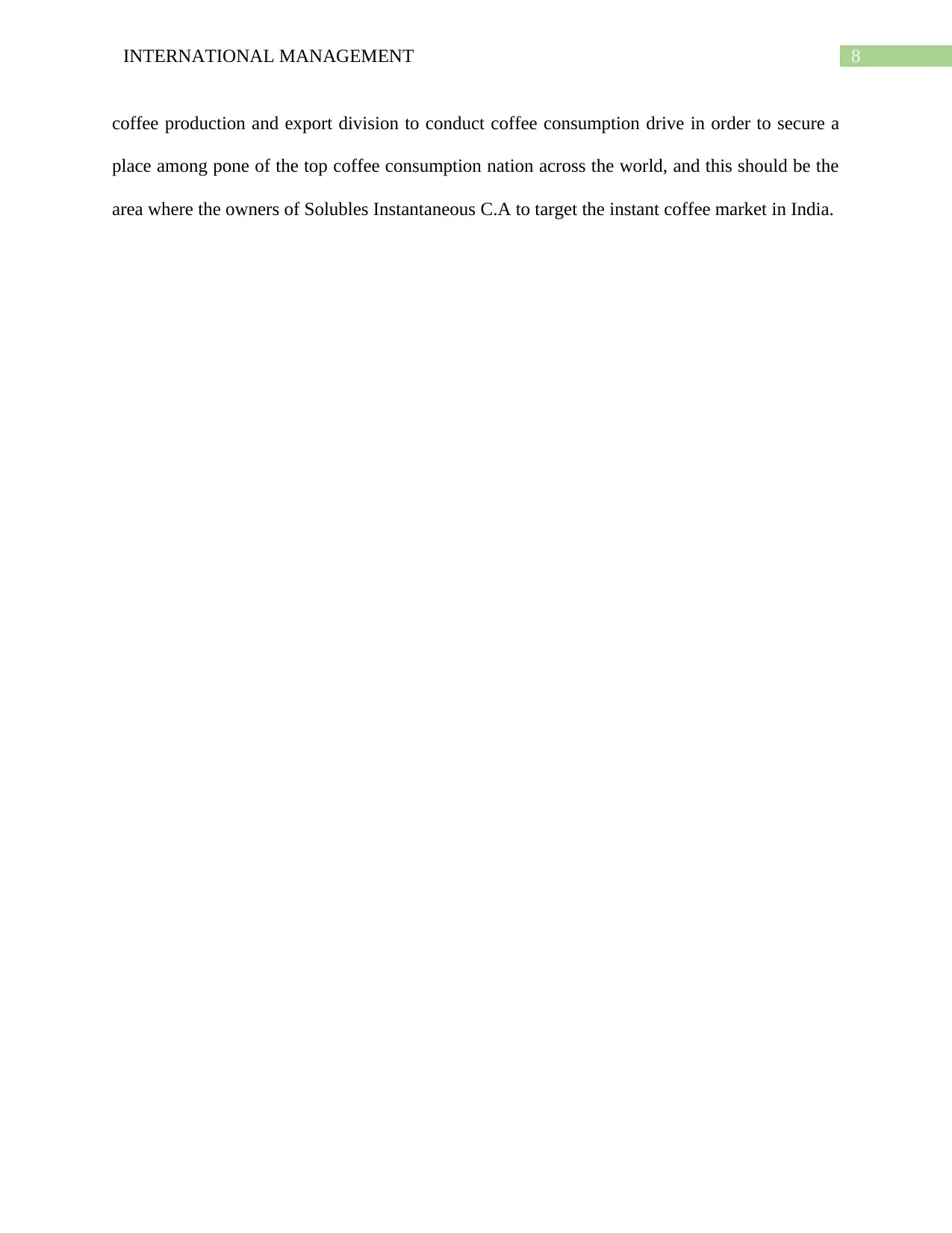
8INTERNATIONAL MANAGEMENT
coffee production and export division to conduct coffee consumption drive in order to secure a
place among pone of the top coffee consumption nation across the world, and this should be the
area where the owners of Solubles Instantaneous C.A to target the instant coffee market in India.
coffee production and export division to conduct coffee consumption drive in order to secure a
place among pone of the top coffee consumption nation across the world, and this should be the
area where the owners of Solubles Instantaneous C.A to target the instant coffee market in India.
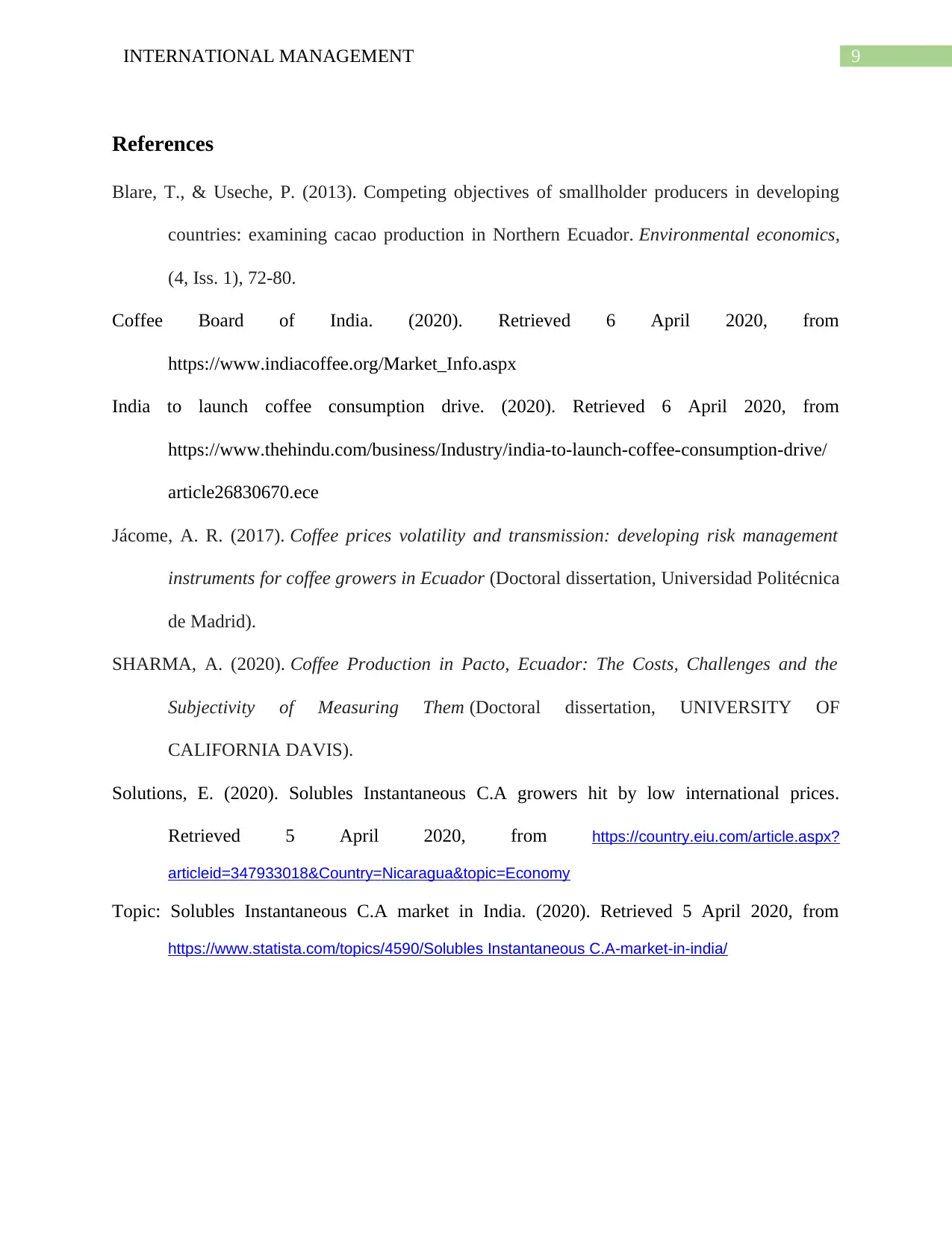
9INTERNATIONAL MANAGEMENT
References
Blare, T., & Useche, P. (2013). Competing objectives of smallholder producers in developing
countries: examining cacao production in Northern Ecuador. Environmental economics,
(4, Iss. 1), 72-80.
Coffee Board of India. (2020). Retrieved 6 April 2020, from
https://www.indiacoffee.org/Market_Info.aspx
India to launch coffee consumption drive. (2020). Retrieved 6 April 2020, from
https://www.thehindu.com/business/Industry/india-to-launch-coffee-consumption-drive/
article26830670.ece
Jácome, A. R. (2017). Coffee prices volatility and transmission: developing risk management
instruments for coffee growers in Ecuador (Doctoral dissertation, Universidad Politécnica
de Madrid).
SHARMA, A. (2020). Coffee Production in Pacto, Ecuador: The Costs, Challenges and the
Subjectivity of Measuring Them (Doctoral dissertation, UNIVERSITY OF
CALIFORNIA DAVIS).
Solutions, E. (2020). Solubles Instantaneous C.A growers hit by low international prices.
Retrieved 5 April 2020, from https://country.eiu.com/article.aspx?
articleid=347933018&Country=Nicaragua&topic=Economy
Topic: Solubles Instantaneous C.A market in India. (2020). Retrieved 5 April 2020, from
https://www.statista.com/topics/4590/Solubles Instantaneous C.A-market-in-india/
References
Blare, T., & Useche, P. (2013). Competing objectives of smallholder producers in developing
countries: examining cacao production in Northern Ecuador. Environmental economics,
(4, Iss. 1), 72-80.
Coffee Board of India. (2020). Retrieved 6 April 2020, from
https://www.indiacoffee.org/Market_Info.aspx
India to launch coffee consumption drive. (2020). Retrieved 6 April 2020, from
https://www.thehindu.com/business/Industry/india-to-launch-coffee-consumption-drive/
article26830670.ece
Jácome, A. R. (2017). Coffee prices volatility and transmission: developing risk management
instruments for coffee growers in Ecuador (Doctoral dissertation, Universidad Politécnica
de Madrid).
SHARMA, A. (2020). Coffee Production in Pacto, Ecuador: The Costs, Challenges and the
Subjectivity of Measuring Them (Doctoral dissertation, UNIVERSITY OF
CALIFORNIA DAVIS).
Solutions, E. (2020). Solubles Instantaneous C.A growers hit by low international prices.
Retrieved 5 April 2020, from https://country.eiu.com/article.aspx?
articleid=347933018&Country=Nicaragua&topic=Economy
Topic: Solubles Instantaneous C.A market in India. (2020). Retrieved 5 April 2020, from
https://www.statista.com/topics/4590/Solubles Instantaneous C.A-market-in-india/
1 out of 10
Your All-in-One AI-Powered Toolkit for Academic Success.
+13062052269
info@desklib.com
Available 24*7 on WhatsApp / Email
![[object Object]](/_next/static/media/star-bottom.7253800d.svg)
Unlock your academic potential
© 2024 | Zucol Services PVT LTD | All rights reserved.